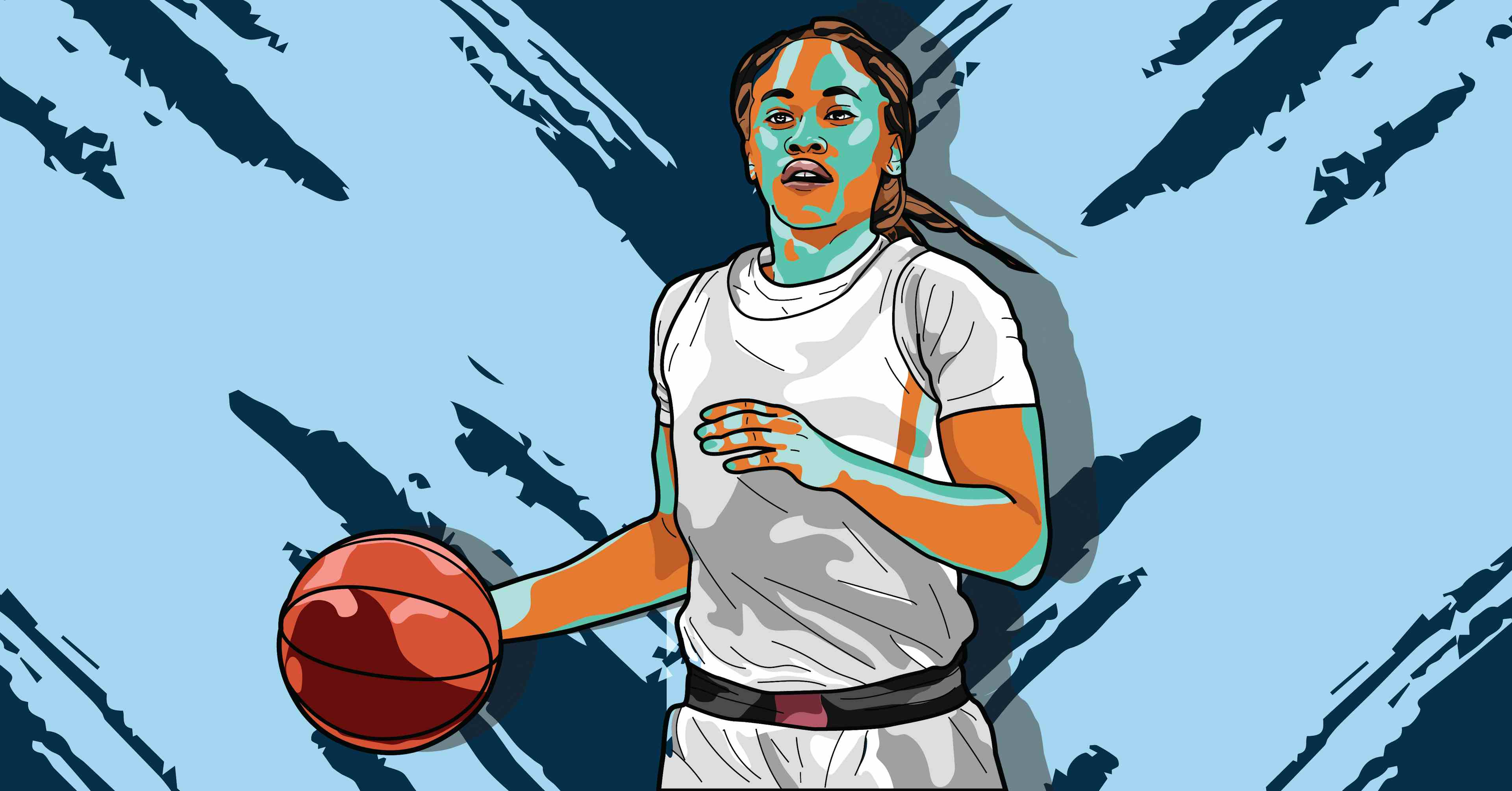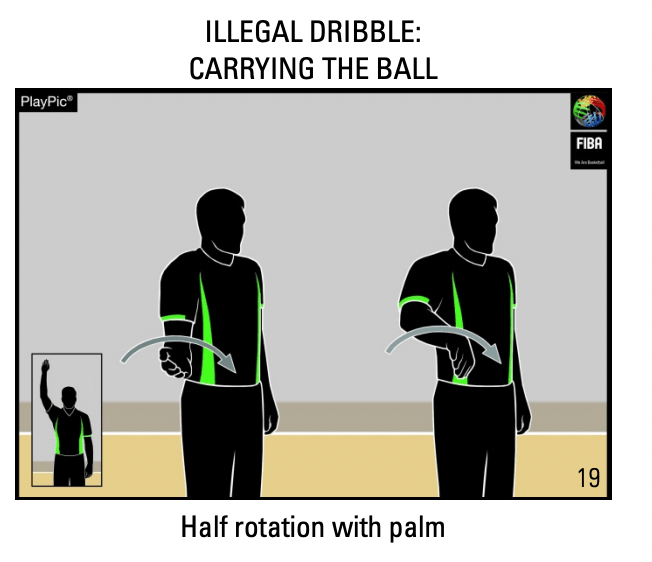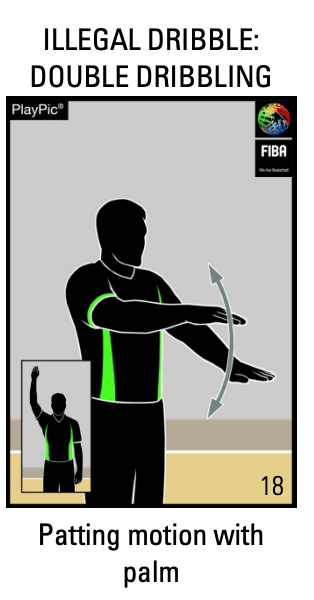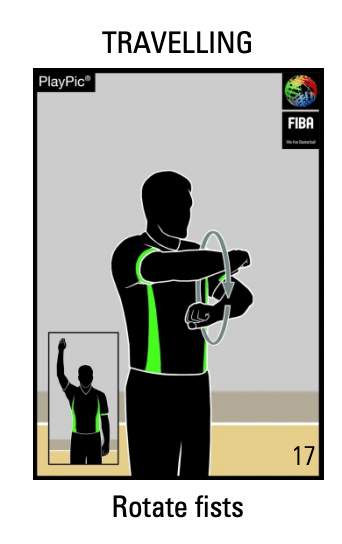
What is a carry in basketball? A carry is a type of illegal dribble where the hooper basically picks up the ball mid-dribble without meaning to, by slipping their hand fully under the ball, and then continues dribbling. It happens when the player moves their hand fully under the ball with their palm up (imagine the way a waiter places their whole hand under a big tray) and holds the ball there for a moment. When a ref calls a carry the other team is awarded the ball.
The FIBA rule book shows the sign a ref uses to call carrying the ball. Which actually is a good visual for the move itself. You can see how the ref sort of mimics the way the hooper’s hand has gone too far under the ball, propping it up, before flipping their hand over it to start dribbling again. To avoid carrying, keep your hand on the top or sides of the ball as you dribble – never fully under it.

In the NBA rule book the carry is defined as: Section II—Dribble (d.) A player who is dribbling may not put any part of his hand under the ball and (1) carry it from one point to another or (2) bring it to a pause and then continue to dribble again.
In the WNBA rule book the carry is defined the same way: Section II—Dribble (d.) A player who is dribbling may not put any part of her hand under the ball and (1) carry it from one point to another or (2) bring it to a pause and then continue to dribble again.
Carrying can happen at any time. But be particularly cautious of carrying when executing these moves:
Don’t get too caught up worrying about carrying, as your anxiety is sure to impact your on-court game. It can be pretty easy to avoid, especially as your handles become stronger. Practice dribbling with your hand on top of the ball, and on the sides. And get lots of practice with float dribbles. Here are a few drills you can use to improve your handles at home.
No, dribbling the ball high is not automatically a carry. Though dribbling the ball too high can cause you to lose control of your dribble, which might lead you to a carry eventually.
So if a carry is putting your hand under the ball, what about the reverse where you control the ball with one hand from above? That’s a technique called palming.
Palming is a move where a player grips the ball with one hand, holding it from the top (rather than the bottom). It is legal to do as long as the player is not also moving their feet or dribbling.
For example, a player can catch a pass, and palm the ball to keep the ball away from the defense, before deciding what move to make. Or as Michael Jordan used to do a lot, you can even use the palm to fake a pass:
The double dribble and traveling (carrying is a type of traveling) are also basketball violations that tend to occur off the dribble. Let’s take a look so you know what these calls are when it comes to game time.
A double dribble is when a hooper is dribbling, fully stops dribbling by picking up the ball and holding it, and then starts dribbling again.
It’s defined in the NBA rule book as: A player may not dribble a second time after he has voluntarily ended his first dribble. The WNBA rule book says the same thing.
The ref’s sign for the double dribble from the FIBA rule book is a patting motion with each palm alternating – basically showing the ball has been dribbled two separate times.

Double dribbling even happens to the pros! Here’s an example of Brooklyn Nets prolific scorer Kevin Durant double dribbling. As you can see he is dribbling with one hand, loses control of the ball, picks it up with two hands, and begins dribbling again.
Traveling happens when a basketball player has the ball and moves their feet more than at most two steps, but does not dribble. This can happen a number of ways: if they move without dribbling at all, if they move or change a pivot foot, or if they take more than two-steps without dribbling the ball as they finish out a move. The ref will call a travel by rotating their fists in a cycling motion.

Let’s explore the three ways this violation can happen.
1. A player must dribble to move their feet: The NBA rule book rule book says: Section II—Dribble (a.) A player shall not run with the ball without dribbling it. The WNBA rule book says the same thing.
Here’s an example of NBA All-Star and Los Angeles Lakers guard Russell Westbrook blatantly traveling as he moves his feet multiple steps without dribbling the ball.
2. A player has two steps after picking up their dribble: Recently the NBA updated the rule book to further clarify this type of traveling, adding new language about the gather, which begins the two-step sequence.
Basically the gather is now the point where the player gains enough control of the ball off a pass, or if they’re already dribbling a ball when they put two hands on it, put a hand under it and pause, or gain enough control of the ball to do something other than dribble with it. So the traveling rule now first allows a gather and then two steps – with the first step starting after the player gathers the ball.
The WNBA defines the two-step rule similarly, allowing a player who gathers the ball while progressing to take two steps in coming to a stop, passing or shooting the ball, or if she has not yet dribbled, one step prior to releasing the ball.
WNBA Champion and Chicago Sky forward Candace Parker shows the correct way to use two steps to get to the basket without traveling here. If she were to take a third step, it would be illegal.
3. A player moves or changes their pivot foot: A travel can also be called if a player moves or changes their pivot foot. So be sure to keep your pivot foot firmly planted and don’t let the defense pressure you into getting off balance.
For example, here NBA champion and Los Angeles Clippers hooper Kawhi Leonard switches his pivot foot after he’s picked up the ball, even though it doesn’t get called:
Now you know all about carrying in basketball, as well as a handful of other violations you might run into on the court. These rules exist to ensure player safety, to keep the game fair, and to uphold the tradition and integrity of basketball. Up next, learn what a double-double is.